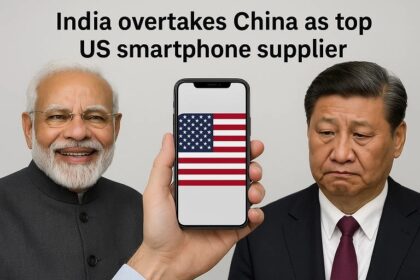HTC Beats Samsung to Market with Vive Eagle AI Smart Glasses
Taipei, August 15, 2025 – HTC has outpaced Samsung by launching the Vive Eagle, the world’s first AI-powered smart glasses available for pre-order, announced on August 14, 2025. Priced at NT$15,600 (~$518), these glasses, exclusively available in Taiwan with a September 1 release, integrate a 12MP ultra-wide camera, voice-activated AI, and real-time translation in 13 languages, positioning HTC as a formidable competitor to Meta’s Ray-Ban glasses and ahead of Samsung’s anticipated 2026 smart glasses debut. This move marks HTC’s bold return to consumer wearables, leveraging its Vive VR expertise to challenge the growing smart glasses market.
A Breakthrough Launch: Vive Eagle’s Features
The Vive Eagle, weighing just 49 grams, features a sleek, Ray-Ban-inspired design with ZEISS sun lenses for UV protection and optical clarity. Powered by Qualcomm’s Snapdragon AR1 Gen 1 chip, 4GB RAM, and 32GB storage, the glasses offer a 12MP ultra-wide camera for voice-activated photo and video capture, open-ear Bose speakers with virtual bass, and a 235mAh battery delivering 4.5 hours of music playback or 36 hours on standby. A 10-minute magnetic fast charge reaches 50% capacity, and an IP54 rating ensures dust and water resistance.
HTC’s Vive AI assistant, supporting Google’s Gemini and OpenAI’s ChatGPT (in beta), enables hands-free control with commands like “Hey Vive, take a photo” and supports real-time translation in languages including Arabic, English, Japanese, and Korean. The glasses prioritize privacy with AES-256 encryption and local data storage, ensuring no content is uploaded or used for AI training. These features position the Vive Eagle as a direct rival to Meta’s Ray-Ban glasses, with superior battery life and translation capabilities.
Feature | Specification | Benefit |
|---|---|---|
Camera | 12MP ultra-wide | High-quality photo/video capture |
AI Assistant | Vive AI (Gemini, ChatGPT) | Voice-activated control, real-time translation |
Battery | 235mAh, 4.5h music, 36h standby | Extended use, fast charging |
Audio | Open-ear Bose speakers | Rich sound, minimal leakage |
Privacy | AES-256 encryption, local storage | Secure, user-controlled data |
Strategic Context: Outpacing Samsung
HTC’s Vive Eagle launch beats Samsung’s rumored smart glasses, expected in late 2026, to market by over a year. According to a report from South Korea’s SE Daily, Samsung’s glasses, designed to rival Meta’s Ray-Ban models, will feature speakers, a microphone, and a camera but lack a display, similar to the Vive Eagle. HTC’s first-mover advantage capitalizes on the growing $7 billion smart glasses market, projected to reach $20 billion by 2030, driven by demand for AI-driven wearables.
HTC, once a smartphone pioneer with models like the HTC One, has pivoted to wearables after exiting the phone market to focus on its Vive VR headsets. The Vive Eagle marks a strategic expansion, with Chris Huang, HTC’s Senior Vice President, stating, “This represents our newest exploration in intelligent living and personal wearables.” The glasses’ Taiwan-only launch, however, limits initial reach, with no confirmed plans for global availability, though posts on X suggest expansion to Europe and the U.S. is under consideration.
Competitor | Product | Launch Timeline | Key Features |
|---|---|---|---|
HTC | Vive Eagle | September 2025 | 12MP camera, AI assistant, 13-language translation |
Samsung | Smart Glasses | Late 2026 | Speakers, microphone, camera (no display) |
Meta | Ray-Ban Meta | Available | 12MP camera, Meta AI, 4h battery |
Android XR Glasses | 2026 | Warby Parker design, Android XR platform |
Industry and Geopolitical Dynamics
The smart glasses race reflects broader tech competition, with Meta leading through Ray-Ban partnerships and Google planning Android XR glasses for 2026. HTC’s entry, alongside Oakley’s recent smart glasses debut, intensifies the market, though its Taiwan-only launch mirrors regional trends like India’s semiconductor push and Kyivstar’s U.S. listing. India’s role as the top U.S. smartphone supplier in Q2 2025 and its Indo-Pacific security partnerships provide a favorable backdrop for tech innovation, though U.S. tariffs (25% on Indian imports, paused in July 2025) and restrictions on Indian tech hiring could impact HTC’s supply chain and global expansion.
On X, reactions are mixed. @NathieVR praised the Vive Eagle’s AI assistant and photo capabilities, while @stufflistings noted its competitive edge with Gemini and ChatGPT integration. @PatentlyApple speculated on future U.S. availability, but @SkarredGhost cautioned that HTC must overcome Meta’s brand dominance.
Challenges and Future Outlook
HTC faces challenges in scaling the Vive Eagle globally, competing with Meta’s established Ray-Ban brand, and navigating supply chain risks amid U.S.-China trade tensions. The Snapdragon AR1 chip, launched in 2023, may lag behind newer processors by 2026, requiring upgrades. Expanding beyond Taiwan and ensuring affordability—given the $518 price compared to Meta’s $299 Ray-Ban glasses—will be critical.
HTC plans to enhance the Vive Eagle with software updates, including full ChatGPT integration by 2026, and explore global markets based on Taiwan’s pre-order success. The company’s focus on privacy and AI-driven features positions it to capture a niche in the smart glasses market, with potential applications in travel, education, and content creation.
Conclusion: HTC’s Bold Return to Wearables
HTC’s Vive Eagle AI smart glasses, launched ahead of Samsung’s 2026 debut, mark a significant milestone in the wearables market. With advanced AI, robust privacy features, and a competitive design, HTC is reasserting its innovation legacy. As India rises in global tech and geopolitical dynamics shift, HTC’s first-mover advantage could redefine the smart glasses landscape, setting the stage for a new era of intelligent wearables.












